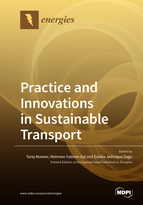Practice and Innovations in Sustainable Transport
A special issue of Energies (ISSN 1996-1073). This special issue belongs to the section "E: Electric Vehicles".
Deadline for manuscript submissions: closed (30 November 2019) | Viewed by 23708
Special Issue Editors
Interests: energy; sustainable energy; solar energy; hydrogen technologies
Special Issues, Collections and Topics in MDPI journals
Interests: solar PV systems; bifacial PV performance; ground albedo enhancement; sustainable buildings; behaviour and attitude of users towards energy consumption
Special Issues, Collections and Topics in MDPI journals
Interests: renewable energies; energy sustainability; climate change; urban planning
Special Issues, Collections and Topics in MDPI journals
Special Issue Information
Dear Colleagues,
The issue of climate change has been discussed within the scientific community as well as in popular media to such an extent that it has become a priori to almost all discussions related to the sustainable use of energy.
For developed economies of Western Europe, transport-related global greenhouse (GHG) emissions are beginning to stabilize, but for the world as a whole these emissions demonstrate a rapidly rising profile. The present proportion of 23% share of CO2 emissions for global transport is set to rise. Road transport is the chief contributor and is responsible for 20% of the total GHG emissions. Marine and air transport jointly contribute, almost equally, to the remainder. It is obvious that the bulk of the emissions problem lies with road transport.
As a follow-up to the Paris Agreement, which has determined that for the globe to halt within a 2oC average temperature increase, the transport sector needs to be decarbonised.
The United Nations estimates that 60% of the world’s population will be living in urban areas by 2030. Cities account for 2 % of the world’s area and for 75% of the world’s energy consumption. For over a century, the automobile has offered affordable freedom of movement within urban areas. Global registrations jumped from 980 million units in 2009 to over 1.2 billion in 2018. The world population exceeded 7 billion in the year 2012, and every seventh person now owns a vehicle, which, in all likelihood, is powered by an internal combustion engine (ICE). Worldwide, 18 million barrels of oil are consumed each day by the automobile sector. Annually, the vehicles emit 2.7 billion tonnes of CO2.
The Nordic region, constituting of Denmark, Finland, Iceland, Norway, and Sweden, has taken a lead on electric vehicles (EVs) with the launch of its Nordic Electric Vehicle Outlook (NEVO2018) report. The EVs offer an elegant solution towards a significant reduction in GHG and kerbside pollution, provided that the electricity for charging the vehicles is sought from renewable means.
This Issue of Energies aims to address the challenge of emissions reduction from the transport sector and the potential solutions that may be available in the near and not-so-distant future.
Prof. Tariq Muneer
Dr. Mehreen Gul
Prof. Dr. Eulalia Jadraque Gago
Guest Editors
Manuscript Submission Information
Manuscripts should be submitted online at www.mdpi.com by registering and logging in to this website. Once you are registered, click here to go to the submission form. Manuscripts can be submitted until the deadline. All submissions that pass pre-check are peer-reviewed. Accepted papers will be published continuously in the journal (as soon as accepted) and will be listed together on the special issue website. Research articles, review articles as well as short communications are invited. For planned papers, a title and short abstract (about 100 words) can be sent to the Editorial Office for announcement on this website.
Submitted manuscripts should not have been published previously, nor be under consideration for publication elsewhere (except conference proceedings papers). All manuscripts are thoroughly refereed through a single-blind peer-review process. A guide for authors and other relevant information for submission of manuscripts is available on the Instructions for Authors page. Energies is an international peer-reviewed open access semimonthly journal published by MDPI.
Please visit the Instructions for Authors page before submitting a manuscript. The Article Processing Charge (APC) for publication in this open access journal is 2600 CHF (Swiss Francs). Submitted papers should be well formatted and use good English. Authors may use MDPI's English editing service prior to publication or during author revisions.
Keywords
- Electric vehicles
- Automobile
- Energy consumption
- Sustainable transport
- GHG and kerbside pollution.








